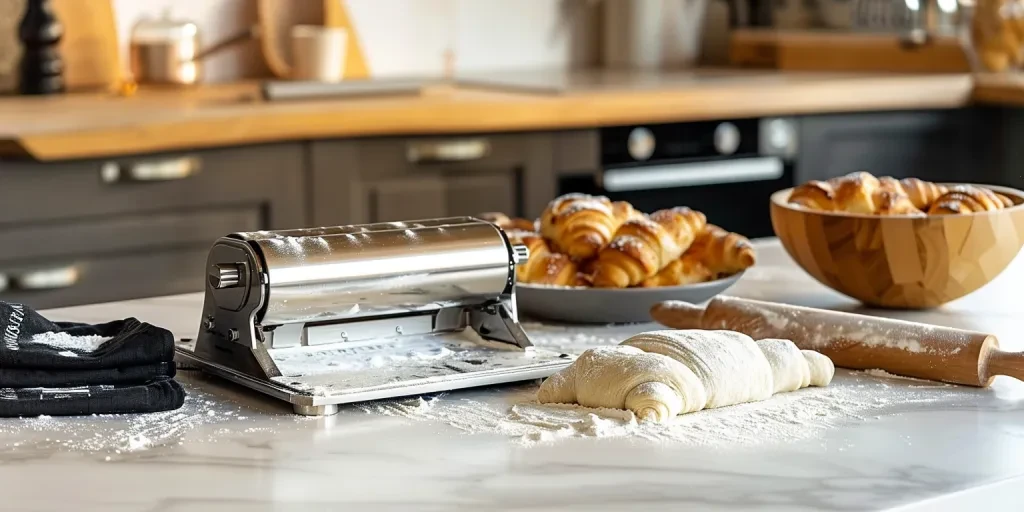В 2025 году рынок хлебопекарного оборудования процветает, чему способствуют достижения в области автоматизации и технологий. В этой статье рассматриваются основные соображения по выбору тестораскаточной машины, предлагая ценные идеи для профессиональных покупателей, чтобы они могли принимать обоснованные решения, повышающие производительность и качество продукции.
Содержание:
-Обзор рынка тестораскаточных машин в 2025 году и далее
-Подробный анализ рынка тестораскаточных машин
-Основные соображения при выборе тестораскаточной машины
-Техническое обслуживание и долговечность тестораскаточных машин
-Энергоэффективность и экологические соображения
-Будущие тенденции в технологии тестораскатки
-Подводя итоги самого важного
Обзор рынка тестораскаточных машин в 2025 году и далее

Мировой рынок тестораскаточных машин, важнейшей части оборудования для обработки хлебобулочных изделий, переживает значительный рост. По состоянию на 2023 год мировой рынок оборудования для обработки хлебобулочных изделий оценивался в 16 млрд долларов США и, по прогнозам, достигнет 24.5 млрд долларов США к 2030 году с годовым темпом прироста (CAGR) в 6.3%. Этот рост обусловлен растущим спросом на автоматизированные и эффективные решения для выпечки, при этом тестораскаточные машины играют ключевую роль в этом расширении.
Что касается регионального роста, рынок оборудования для переработки хлебобулочных изделий в США, включая тестораскаточные машины, оценивается в 4.2 млрд долларов США в 2023 году. Прогнозируется, что в Китае среднегодовой темп роста составит 9.7%, достигнув 5.9 млрд долларов США к 2030 году. Ожидается, что Азиатско-Тихоокеанский регион, включая такие страны, как Япония, Индия и Южная Корея, также продемонстрирует устойчивый рост за счет увеличения потребления хлебобулочных изделий и внедрения передового хлебопекарного оборудования.
Сегментация рынка оборудования для обработки хлебобулочных изделий показывает, что сегмент печей и расстойных шкафов достигнет 8.5 млрд долларов США к 2030 году, увеличившись на CAGR 6.3%. Миксеры и блендеры также должны расти на 6.2% в течение следующих семи лет. Эти цифры подчеркивают важность тестораскаточных машин как части более широкого рынка оборудования для хлебобулочных изделий, подчеркивая их важную роль в достижении последовательной высококачественной подготовки теста.
Подробный анализ рынка тестораскаточных машин
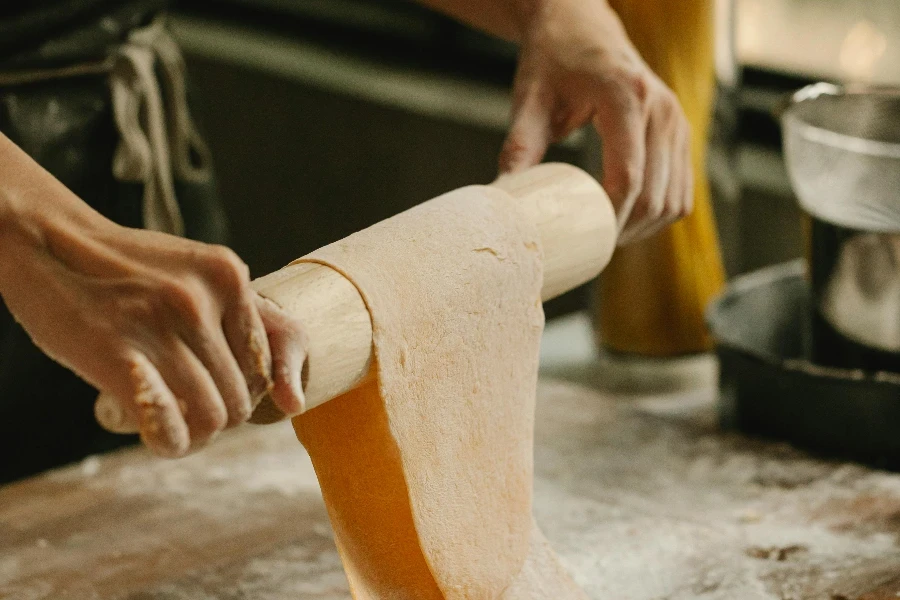
Тестораскаточные машины незаменимы в коммерческих пекарнях из-за их способности производить равномерно раскатанное тесто, что необходимо для разнообразных хлебобулочных изделий. Динамика рынка тестораскаточных машин зависит от нескольких факторов, включая технологические достижения, изменения в поведении потребителей и экономические факторы. Интеграция цифровизации и автоматизации в тестораскаточные машины значительно повысила их эффективность и простоту использования, что делает их предпочтительным выбором для современных пекарен.
Показатели производительности для тестораскаточных машин изменились, и теперь ключевыми показателями являются скорость, точность и простота обслуживания. Высокопроизводительные тестораскаточные машины могут обрабатывать большие объемы теста с минимальным ручным вмешательством, что имеет решающее значение для крупных пекарен. Такие известные бренды, как Bühler и John Bean Technologies Corporation, доминируют на рынке благодаря своей репутации в области качества и инноваций.
Экономические факторы, такие как рост располагаемых доходов и урбанизация, привели к увеличению спроса на хлебобулочные изделия, тем самым увеличивая спрос на тестораскаточные машины. Кроме того, изменение потребительского поведения в сторону полуфабрикатов и растущая тенденция домашней выпечки еще больше стимулировали рост рынка. Платформы онлайн-продаж набирают обороты благодаря своему удобству и более широкому охвату.
Последние инновации в технологии тестораскаточных машин включают внедрение IoT для мониторинга в реальном времени и предиктивного обслуживания, повышения эффективности работы и сокращения простоев. Этапы жизненного цикла продукта тестораскаточных машин становятся короче, поскольку производители постоянно внедряют инновации для удовлетворения меняющихся требований рынка. Тенденции цифровизации, такие как использование ИИ для оптимизации консистенции и текстуры теста, становятся преобладающими в отрасли.
Проблемы клиентов, такие как высокая начальная стоимость и требования к обслуживанию тестораскаточных машин, решаются с помощью вариантов финансирования и улучшенных служб поддержки клиентов. Стратегии позиционирования бренда сосредоточены на надежности, технологических инновациях и устойчивости. Стратегии дифференциации включают предложение настраиваемых решений для удовлетворения конкретных потребностей хлебопекарной промышленности, таких как производство безглютенового или специального теста.
Нишевые рынки для тестораскаточных машин включают ремесленные пекарни и небольшие коммерческие кухни, где точность и качество имеют первостепенное значение. Эти сегменты все чаще используют усовершенствованные тестораскаточные машины для повышения качества и однородности продукции. В целом рынок тестораскаточных машин готов к значительному росту, обусловленному технологическими достижениями, меняющимися предпочтениями потребителей и расширяющейся глобальной хлебопекарной промышленностью.
Ключевые моменты при выборе тестораскаточной машины
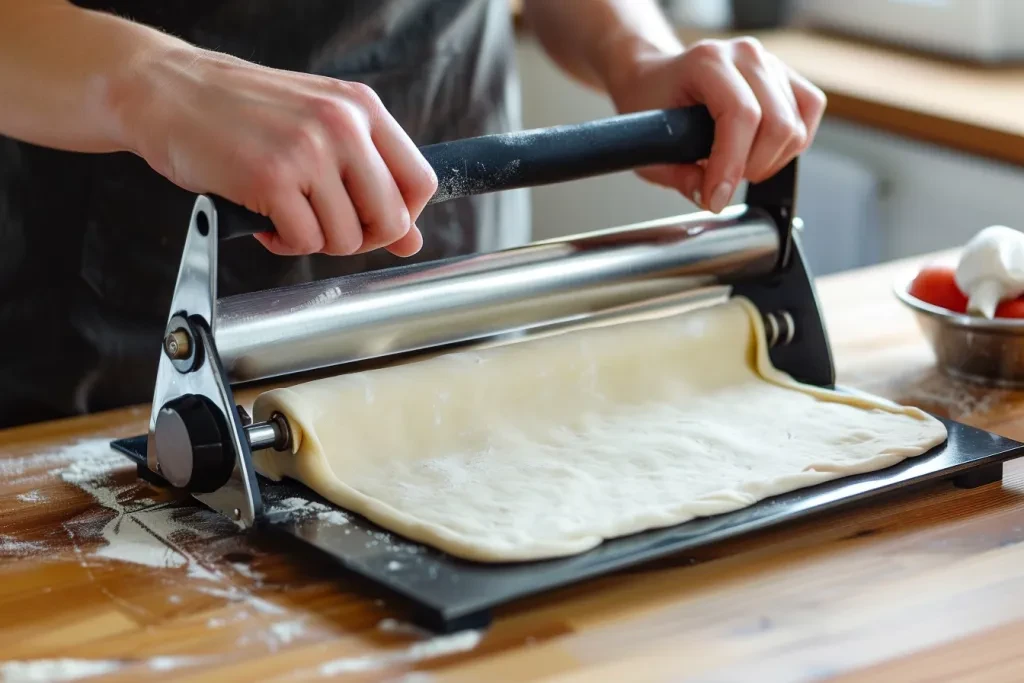
При выборе тестораскаточной машины для вашей пекарни учитывайте такие факторы, как тип, производительность, конструкция, простота использования и цена.
Типы и виды тестораскаточных машин
Тестораскаточные машины бывают разных типов, чтобы соответствовать различным потребностям в выпечке. Распространенные типы включают настольные, напольные и реверсивные тестораскаточные машины.
Настольные тестораскаточные машины компактны, портативны и идеально подходят для небольших и средних пекарен с ограниченным пространством. Они идеально подходят для раскатывания небольших партий теста, что делает их подходящими для ремесленных пекарен и кондитерских.
Напольные тестораскаточные машины предназначены для крупносерийного производства. Эти прочные машины обрабатывают большие партии теста, что делает их подходящими для крупных пекарен и коммерческих кухонь. Они часто оснащены регулируемыми роликами и конвейерными лентами для оптимизации процесса раскатки теста.
Реверсивные тестораскаточные машины могут раскатывать тесто в обоих направлениях, достигая равномерной толщины и консистенции. Эти универсальные машины можно использовать для различных типов теста, включая слоеное тесто, круассаны и тесто для пиццы.
Производительность и функциональность
Производительность и функциональность тестораскаточной машины имеют решающее значение. Ключевые показатели производительности включают скорость, однородность и способность обрабатывать различные типы теста.
Скорость имеет решающее значение для операций с большим объемом. Тестораскаточная машина с регулируемой скоростью обеспечивает лучший контроль, гарантируя, что тесто будет раскатано до нужной толщины быстро и эффективно.
Консистенция имеет решающее значение. Высококачественная тестораскаточная машина должна обеспечивать равномерную толщину по всему пласту теста. Ищите машины с точными роликами и регулируемыми настройками толщины.
Способность работать с различными типами теста важна. Некоторые тестораскаточные машины предназначены для определенных типов теста, в то время как другие являются универсальными. Убедитесь, что выбранная вами машина может работать с определенными типами теста, с которыми вы работаете, будь то тесто для хлеба, выпечки или пиццы.
Конструкция и технические характеристики
Конструкция и технические характеристики тестораскаточной машины влияют на ее эффективность и простоту использования. Примите во внимание такие факторы, как размер, вес и материалы конструкции.
Убедитесь, что размер тестораскаточной машины соответствует доступному пространству в вашей пекарне. Тщательно измерьте свое рабочее пространство и выберите машину, которая вам удобно подойдет.
Вес — еще один фактор, особенно если вам нужно часто перемещать машину. Легкие модели проще транспортировать и хранить, в то время как более тяжелые модели могут обеспечить большую устойчивость во время работы.
Строительные материалы играют решающую роль в долговечности и гигиене машины. Нержавеющая сталь является популярным выбором из-за ее прочности, коррозионной стойкости и простоты очистки. Убедитесь, что компоненты машины изготовлены из высококачественных материалов, которые могут выдерживать ежедневное использование.
Простота в использовании
Простота использования имеет решающее значение, особенно для пекарен, где оборудование используют несколько сотрудников. Ищите удобные для пользователя функции, такие как интуитивно понятное управление, легко читаемые дисплеи и эргономичный дизайн.
Интуитивно понятное управление облегчает операторам настройку параметров и контроль процесса листования. Цифровые дисплеи и панели управления с четкими индикаторами могут помочь оптимизировать операции и сократить время обучения для новых пользователей.
Эргономичные конструкции повышают комфорт оператора и снижают риск усталости или травм. Такие функции, как регулируемые настройки высоты, легкодоступные компоненты и плавно работающие рычаги, способствуют более комфортной и эффективной рабочей среде.
Ценовой диапазон и бюджет
Диапазон цен и бюджет важны при инвестировании в новое оборудование. Тестораскаточные машины продаются по разным ценам в зависимости от их характеристик, размера и марки.
Хотя соблазнительно выбрать самый дешевый вариант, рассмотрите долгосрочную ценность и окупаемость инвестиций. Высококачественные тестораскаточные машины могут иметь более высокую первоначальную стоимость, но часто предлагают лучшую производительность, долговечность и эффективность, экономя ваши деньги в долгосрочной перспективе.
При выборе тестораскаточной машины учитывайте особые потребности вашей пекарни и бюджетные ограничения. Оцените характеристики и возможности машины в соответствии с вашими производственными требованиями, чтобы убедиться, что вы делаете экономически выгодные инвестиции.
Техническое обслуживание и долговечность тестораскаточных машин
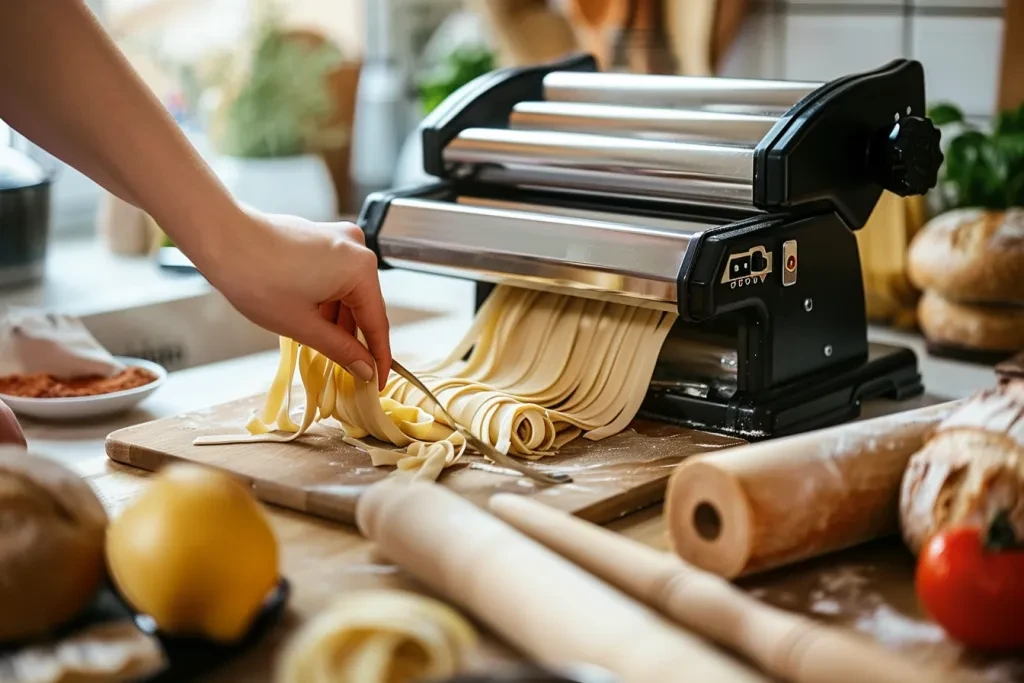
Обеспечение долговечности и оптимальной производительности вашей тестораскаточной машины требует регулярного обслуживания и надлежащего ухода. Это продлевает срок службы машины и гарантирует стабильные результаты.
Регулярная очистка и смазка
Регулярная очистка предотвращает накопление остатков теста на роликах и других компонентах. После каждого использования удаляйте все остатки теста и тщательно очищайте машину влажной тканью. Избегайте использования едких химикатов, которые могут повредить поверхность машины.
Смазка обеспечивает плавную работу подвижных частей. Ознакомьтесь с рекомендациями производителя по рекомендуемым смазочным материалам и графикам смазки. Регулярно смазывайте ролики, шестерни и подшипники, чтобы уменьшить трение и износ.
Периодические проверки и регулировки
Проводите периодические проверки на предмет износа или повреждений. Особое внимание уделяйте роликам, ремням и электрическим компонентам. Незамедлительно устраняйте любые проблемы, чтобы предотвратить дальнейшие повреждения.
Для поддержания оптимальной производительности может потребоваться регулировка. Со временем может потребоваться перенастройка роликов для обеспечения постоянной толщины теста. Следуйте инструкциям производителя по выполнению этих регулировок или при необходимости проконсультируйтесь с профессиональным техником.
Замена изношенных деталей
Несмотря на регулярное обслуживание, некоторые детали могут со временем изнашиваться и требовать замены. Имейте запас необходимых запасных частей, таких как ролики, ремни и подшипники, чтобы минимизировать время простоя при необходимости замены.
Покупайте запасные части у надежных поставщиков, чтобы гарантировать совместимость и качество. Использование оригинальных деталей, рекомендованных производителем, может помочь сохранить производительность машины и продлить срок ее службы.
Энергоэффективность и экологические аспекты
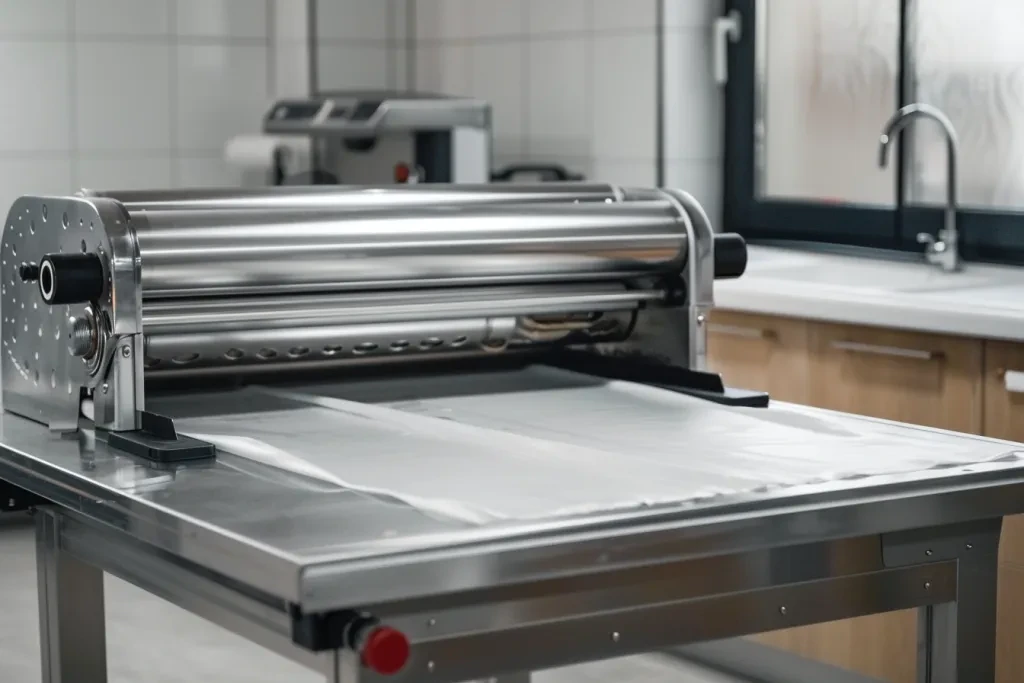
Энергоэффективность становится все более важной в хлебопекарной промышленности для экономии затрат и экологической устойчивости. Современные тестораскаточные машины разработаны с энергосберегающими функциями для снижения потребления энергии и минимизации воздействия на окружающую среду.
Энергоэффективные двигатели и элементы управления
Энергоэффективные двигатели и элементы управления могут значительно снизить энергопотребление тестораскаточных машин. Ищите машины, оснащенные частотно-регулируемыми приводами (VSD), которые позволяют точно контролировать скорость и крутящий момент двигателя. VSD могут регулировать выходную мощность двигателя в зависимости от нагрузки, сокращая потребление энергии в периоды низкого спроса.
Некоторые тестораскаточные машины также оснащены функциями автоматического отключения, которые выключают машину, когда она не используется, что еще больше экономит энергию. Эти функции снижают эксплуатационные расходы и способствуют более устойчивой работе.
Устойчивые материалы и методы производства
Рассмотрите воздействие на окружающую среду материалов и производственных методов, используемых при производстве тестораскаточных машин. Машины, изготовленные из перерабатываемых материалов, таких как нержавеющая сталь и алюминий, более экологичны и могут быть переработаны по окончании срока службы.
Производители, которые отдают приоритет устойчивым практикам, таким как сокращение отходов и минимизация потребления энергии в процессе производства, вносят вклад в более зеленую отрасль. Изучите инициативы и сертификации производителей в области устойчивого развития, чтобы принять обоснованное решение.
Сокращение отходов и переработка
Внедрение методов сокращения отходов и переработки в вашей пекарне может дополнить энергоэффективные функции вашей тестораскаточной машины. Используйте листы и аксессуары для тестораскаточной машины, которые можно использовать повторно и перерабатывать, чтобы минимизировать отходы.
Поощряйте сотрудников следовать лучшим практикам сокращения отходов, таким как повторное использование обрезков теста и переработка упаковочных материалов. Приняв комплексный подход к устойчивому развитию, вы можете повысить общую эффективность и экологические показатели вашей пекарни.
Будущие тенденции в технологии раскатки теста
По мере развития технологий тестораскаточные машины становятся все более сложными и многофункциональными. Осведомленность о будущих тенденциях может помочь вам сделать стратегические инвестиции в оборудование, которое позволит вашей пекарне оставаться конкурентоспособной.
Автоматизация и умные технологии
Автоматизация является ключевой тенденцией в хлебопекарной промышленности, при этом тестораскаточные машины все чаще включают в себя интеллектуальные технологии и функции автоматизации. Автоматизированные тестораскаточные машины могут оптимизировать процесс раскатки теста, уменьшая необходимость ручного вмешательства и увеличивая производительность.
Умные технологии, такие как программируемые настройки и сенсорные интерфейсы, позволяют операторам настраивать и сохранять определенные параметры раскатки. Это обеспечивает постоянство и точность даже при использовании разных типов теста и рецептов.
Интеграция с другим хлебопекарным оборудованием
Интеграция с другим хлебопекарным оборудованием — еще одна новая тенденция. Тестораскаточные машины, которые могут легко соединяться с миксерами, расстойными шкафами и печами, создают более эффективную и сплоченную производственную линию.
Например, некоторые усовершенствованные тестораскаточные машины могут взаимодействовать с миксерами для получения теста сразу после смешивания, сокращая время обработки и передачи. Такая интеграция повышает эффективность рабочего процесса и сводит к минимуму риск загрязнения или ухудшения качества теста.
Расширенные функции безопасности
Безопасность остается главным приоритетом в хлебопекарной деятельности, и ожидается, что будущие тестораскаточные машины будут оснащены усовершенствованными механизмами безопасности. Они могут включать усовершенствованные датчики и функции автоматического отключения для предотвращения несчастных случаев и травм.
Эргономичные конструкции, которые снижают нагрузку и усталость оператора, также станут более распространенными. Такие функции, как регулируемые настройки высоты и легкодоступные элементы управления, способствуют созданию более безопасной и комфортной рабочей среды.
Подведем итоги
Выбор правильной тестораскаточной машины — это важнейшее решение для любой пекарни, влияющее на производительность, качество продукции и общую эффективность. Рассмотрев такие факторы, как типы и стили, производительность, дизайн, простота использования и бюджет, вы можете сделать осознанный выбор, который соответствует вашим конкретным потребностям. Регулярное техническое обслуживание, энергоэффективность и отслеживание будущих тенденций еще больше обеспечат долговечность и оптимальную производительность вашей тестораскаточной машины, сохраняя вашу пекарню на переднем крае отрасли.
